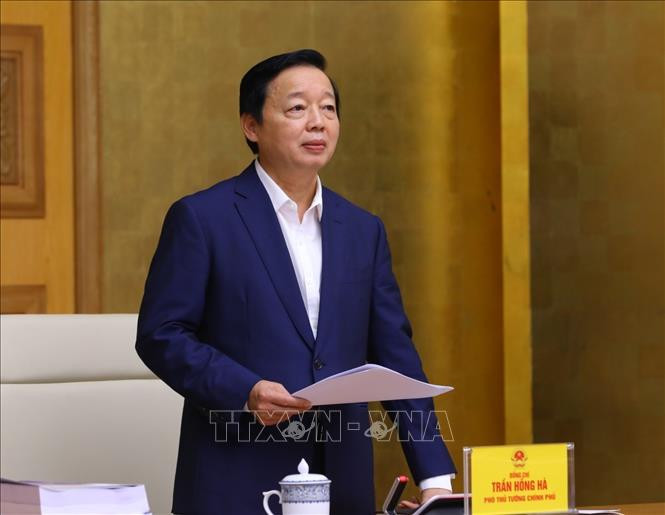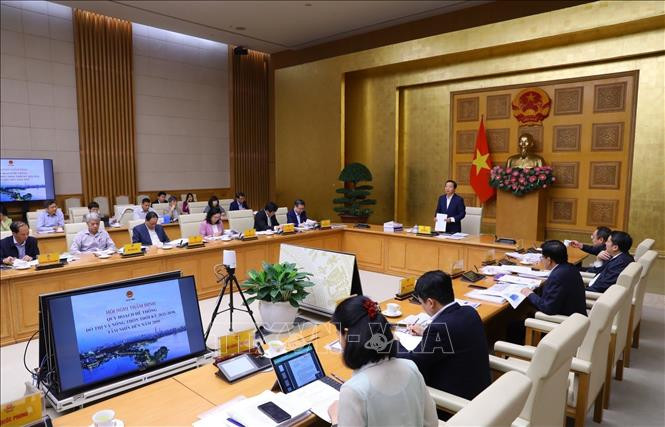On November 24, at the Government Headquarters, Deputy Prime Minister Tran Hong Ha chaired a meeting of the Council for Appraisal of the Urban and Rural System Planning for the 2021-2030 period, with a vision to 2050 (Planning).

At the meeting, Deputy Prime Minister Tran Hong Ha emphasized that this is the first time that the Planning of urban and rural systems, living space, future development, and people's livelihoods has been established at the national level. Therefore, the Planning must be a tool to concretize and realize the orientations, goals, and tasks of the Party and State on industrialization, modernization, energy conversion, infrastructure, culture-society, education, health, and national security and defense.
Accordingly, the Urban and Rural System Planning must be spatially connected to national, regional and specialized master plans. In addition to clarifying and completing the legal basis, the consulting unit, the Deputy Prime Minister requested that experts and scientists develop and supplement concepts, criteria as the basis and methods for planning, "access full information on the natural environment, climate change, geological and geomorphological maps... to decide on specific functions and conditions for urban and rural development.
"The planning must point out issues of management, methodology, shortcomings and limitations in urban and rural areas, thereby determining immediate and long-term work and a specific and appropriate implementation roadmap," the Deputy Prime Minister suggested.
Presenting some consistent orientations when establishing and implementing the Plan, the Deputy Prime Minister emphasized that the Plan needs to pay attention to living space, conservation, cultural and natural factors, along with buffer zone space, and finally development space.
Agreeing with the view that “without infrastructure, development is impossible”, the Deputy Prime Minister noted that the situation of “following the route” should be avoided, instead, the urban development model should be oriented towards public transport. At the same time, the Plan clarifies the rural economy in terms of services, trade, tourism, processing, craft village development, etc.; focusing on the differences and cultural characteristics of coastal, mountainous and delta rural areas, in which, the quality of the natural environment as well as the inherent values of the countryside should be emphasized.
Emphasizing that the Planning is the first step in shaping scientific and legal issues and building criteria, the Deputy Prime Minister requested a full analysis of practical models to determine the next development direction of cluster cities, especially satellite cities within the city; building comprehensive criteria to visualize and grasp the current space and solve future problems.
According to the report at the meeting, before the time of the Planning, the country had many national, regional and specialized urban centers; initially forming national and regional urban areas. Urban administrative space expanded at the three levels of province, district and commune. Rural urbanization took place in many places.

The primary viewpoint of the Planning is to develop urban areas into a driving force that plays a pivotal role in economic development. Rural areas are the foundation for sustainable urban development. Urban and rural areas are linked to national socio-economic development zoning, with a focus and key points, effectively linked to the infrastructure system, especially key national projects.
By 2030, the urbanization rate of the whole country is expected to reach over 50% with about 1,000-1,200 urban areas, including 4 urban areas (Hanoi, Ho Chi Minh City, Da Nang and Can Tho). Urban areas will contribute about 85% of GDP to the economy.
Rural areas are planned, developed comprehensively, modernly, greenly, cleanly, and beautifully, associated with the urbanization process; have infrastructure and social services that are synchronous and close to urban areas; preserve and promote national cultural identity; transform economic structure and organize production reasonably, creating sustainable livelihoods; maintain stability in rural society, improve people's knowledge, ensure security and order, etc.
The goal set for 2030 is that 90% of communes nationwide will meet new rural standards, of which 50% will meet advanced new rural standards...
Also at the meeting, the reviewers, representatives of a number of ministries and branches proposed solutions to ensure the urban and rural technical infrastructure system; mechanisms and policies to ensure urban-rural connectivity in regional and sectoral linkages. Principles and criteria for distributing and organizing rural residential areas associated with agricultural and natural ecological zones, ensuring livelihoods with diverse economic activities, preserving cultural identity, preventing natural disasters and landslides. The main environmental issues raised in the Planning include the decline in reserves, water quality, air, biodiversity; increased solid waste, risks of natural disasters and environmental incidents, etc.
According to VNA